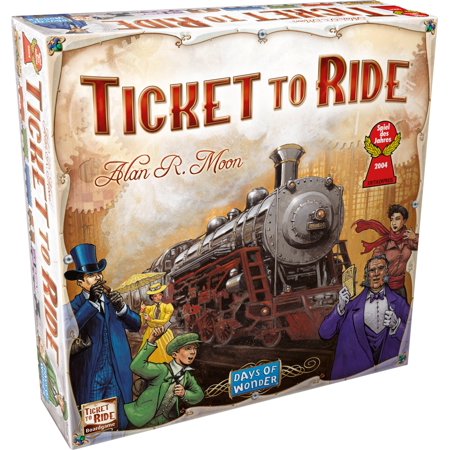Ticket to Ride
Players: 2-5
Ages: 7 and up
Purchase: Buy on Amazon (affiliate link)
Math Ideas: Addition, probability, spatial reasoning
Questions to Ask:
Which paths might you take to your destination?
How many points will you earn for the path you've chosen?
Should you draw a new destination card? How do you make that decision?
Ticket to Ride is a phenomenon for a reason: The game is just plain fun.
I remember when I first realized how enjoyable and versatile the game was: I brought it over to my dad's on Thanksgiving, and we played a nice, friendly face-up version of the game with my son and a couple of his cousins. Then I left the game over there that night, in case anyone wanted to play later.
The next day, my dad told me about the brutal, conniving, back-stabbing game of Ticket to Ride that the adults had played the night before.
I figure that when a game is just as fun played face-up or face-down, it's a keeper. Ticket to Ride is definitely more expensive than the typical game that I recommend, so maybe it works best as a birthday present than an impulse purchase. But it's strategically deep enough to remain a big part of your board game rotation for years.
How to Play
The goal of Ticket to Ride is to build train lines between the major cities of North America. At the start of the game, each player draws several destination cards like the one at left. If you draw this card, your goal is to build a train line from New York to LA. If you succeed, you'll earn 21 points at the end of the game.
At the start of each turn, a player can choose to either draw cards or build a train route. Train routes can be built when you hold cards whose color matches the route you are trying to build. If the route between Miami and Atlanta has five blue spaces, then you'll need five blue cards to build that train.
You earn points in three ways: First, you can earn points simply be building a new addition to your train line. Secondly, you earn points for completing a destination (like the 21 points in the example above). Finally, you earn points at the conclusion of the game if you created the longest train line. The player at the end of the game with the most points, wins.
I recommend playing face-up at first, so you and your family can share ideas and discuss strategies. In fact, my son has only played the face-up version and loves it.
I've deliberately made these instructions more of an overview; if you want a fuller guide to the rules of the game, check out the video below.
Where's the Math?
Ticket to Ride is a great family game because it ties several mathematical ideas together without seeming overtly math-y.
First of all, there is the central tension of the game: Do you build the most direct route possible, or do you make a longer, more winding path to your destination? On one hand, the more routes you complete, the more points you'll earn from your destination cards. On the other hand, longer routes mean more points, and you might end the game with the bonus for the longest total route!
A similar challenge presents itself as the game moves along: Should you stick with your original destinations, or try to draw new destinations to complete before the game ends? If you complete a destination, you of course get the points on the card. But if you draw a destination and don't complete the route, the points on the card are deducted from your total!
In Ticket to Ride, nobody rides for free. There are always trade-offs in every decision you make, and those trade-offs can be analyzed mathematically.
Questions to Ask
As I said above, I strongly recommend that you play this game face-up, at least to start. This will make the game feel more approachable for your kids, and it will also help you find ways to ask questions.
At the start of the game, let your child find their cities on the board. Then ask "What routes could you build from one city to the other?" Your child could talk through their options, keeping in mind the types of cards that will be required to create each piece of their route.
Once they've decided, ask "How many points will you earn for the route you're creating?" This question will get your child working on mental math as they add the points from each individual segment to find their total points. Maybe there's another path that, while longer, might give some more points! But of course it'll be harder to actually complete. Like I said, no free rides...
When they've completed their first couple of routes, they will probably want to draw a new destination or two. As I mentioned above, these cards are a double-edged sword! Make sure you ask your child "When should you draw a new destination card? What should you consider beforehand?" They might want to consider the number of train cars they have remaining, the amount of routes already claimed, and other sorts of elements before deciding to draw that new destination.
Ticket to Ride is the sort of game that I'm happy to bring to the table whether I'm playing with kids or adults. I hope you and your family enjoy it as much as we do.
Click here to buy Ticket to Ride on Amazon (affiliate link)






